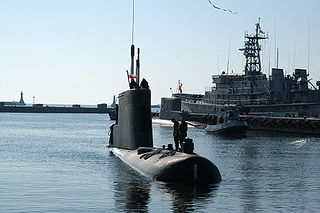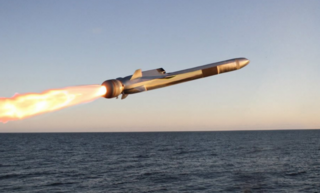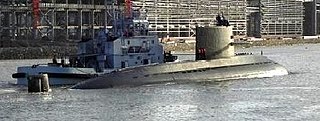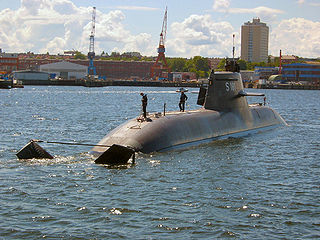
The German Navy is the navy of Germany and part of the unified Bundeswehr, the German Armed Forces. The German Navy was originally known as the Bundesmarine from 1956 to 1995, when Deutsche Marine became the official name with respect to the 1990 incorporation of the East German Volksmarine. It is deeply integrated into the NATO alliance. Its primary mission is protection of Germany's territorial waters and maritime infrastructure as well as sea lines of communication. Apart from this, the German Navy participates in peacekeeping operations, and renders humanitarian assistance and disaster relief. It also participates in anti-piracy operations.

The Royal Norwegian Navy is the branch of the Norwegian Armed Forces responsible for naval operations of Norway, including those of the Norwegian Coast Guard. As of 2008, the Royal Norwegian Navy consists of approximately 3,700 personnel and 70 vessels, including 4 heavy frigates, 6 submarines, 14 patrol boats, 4 minesweepers, 4 minehunters, 1 mine detection vessel, 4 support vessels and 2 training vessels.

The Type 212A is a class of diesel-electric submarine developed by Howaldtswerke-Deutsche Werft AG (HDW) for the German Navy, and the Italian Navy where it is known as the Todaro class. It features diesel propulsion and an additional air-independent propulsion (AIP) system using Siemens proton-exchange membrane (PEM) compressed hydrogen fuel cells. The submarines can operate at high speed on diesel power or switch to the AIP system for silent slow cruising, staying submerged for up to three weeks with little exhaust heat. The system is also said to be vibration-free and virtually undetectable.

ORP Bielik, formerly HNoMS Svenner (S309), was one of four Kobben-class submarines in service with the Polish Navy. The vessel and its sister ships were built in the period 1964–1967 by Rheinstahl Nordseewerke GmbH in Emden, West Germany for the Royal Norwegian Navy. The Kobben-class submarines were given to Poland in the 2002–2004 period after having been replaced by Ula-class submarines in Norway. Before entering active Polish service the boat was modified in Gdańsk. She was decommissioned in December 2021 alongside her sister Sęp, with the decommissioning marking the end of active service for the Kobben-class submarines.
HMS P41 was a Royal Navy U-class submarine built by Vickers-Armstrong. She was transferred to the exiled Royal Norwegian Navy before completion and renamed HNoMS Uredd. She and one of the B-class in 1940 have so far been the only Norwegian submarines to have been sunk.

The Naval Strike Missile (NSM) is an anti-ship and land-attack missile developed by the Norwegian company Kongsberg Defence & Aerospace (KDA).

The Type 206 is a class of diesel-electric submarines (U-boats) developed by Howaldtswerke-Deutsche Werft (HDW). Its design is based on the preceding Type 205 submarine class. These small and agile submarines were built during the Cold War to operate in the shallow Baltic Sea and attack Warsaw Pact shipping in the event of military confrontation. The pressure hulls were built out of non-magnetic steel to counter the threat of magnetic naval mines and make detection with MAD sensors more difficult. The low emission profile allowed the submarines in exercises to intrude even into well-protected opposing forces such as carrier formations with their screen.

Nordseewerke Emden GmbH was a shipbuilding company, located in the Emden Harbor of the north German city of Emden. Founded in 1903, shipbuilding ended in 2010, and the company was taken over by the Schaaf Industrie AG, which among other products, makes components for off-shore systems.
The Snøgg class was a Royal Norwegian Navy class of fast patrol boats (FPB). It might also be classified as a torpedo boat or a missile boat. In Norway this type of vessel is called a missile torpedo boat (MTB). The class was named after its lead vessel, Snøgg, which is a Norwegian word meaning "fast". All of the subsequent names are synonyms of "fast".

The Kobben class is a customized version of the German Type 205 submarine. Fifteen vessels of this class were built for use by the Royal Norwegian Navy in the 1960s. The class later saw service with Denmark and Poland. The boats have since been withdrawn from service in the Norwegian and Danish navies. The Polish Navy operated two Kobben-class submarines until 2021.

The Type 039A submarine is a class of diesel-electric submarine in China's People's Liberation Army Navy. It is China's first AIP powered submarine and presumed to be one of the quietest diesel-electric submarine classes in service. This class is the successor of the Type 039 submarine. The official Chinese designation is 039A as the ship is based on the 039 class, but as the 039A has very little resemblance to the 039 it is commonly referred to as the Type 041. The class is designed to replace the aging Type 033 and the older Type 035 submarines that previously formed the backbone of the conventional submarine force.

U-31 (S181) is a Type 212A submarine of the German Navy, and the lead ship of her class.

IDAS is a medium-range missile currently being developed for the Type 209 and Type 212A submarine class of the German Navy.

The Norwegian armed forces in exile were remnants of the armed forces of Norway that continued to fight the Axis powers from Allied countries, such as Britain and Canada, after they had escaped the German conquest of Norway during World War II.

HNoMS Ula, previously HMS Varne, a British-built U-class submarine, and a member of the third group of that class to be built. She never actually served under the name Varne, being transferred before commissioning to the exiled Royal Norwegian Navy as HNoMS Ula (S300). In 1944 she sank a German U-boat during one of her patrols off Norway. She remained in Norwegian service and was scrapped in 1965.

The Heroine class are a variant of the Type 209 diesel-electric attack submarine developed by Howaldtswerke-Deutsche Werft (HDW) of Germany, currently in service with the South African Navy. The class is composed of three vessels.
HNoMS Utstein is a series of three submarines operated by the Royal Norwegian Navy. They were named after a historic Utstein Abbey which is located on the island of Klosterøy in Rennesøy, Norway. The three submarines that have borne this name are:
The Type 212CD class is a submarine class developed by ThyssenKrupp Marine Systems (TKMS) for the Norwegian and German navies. The class is derived from the Type 212 submarine class, but will be significantly larger than the 212 class.

















